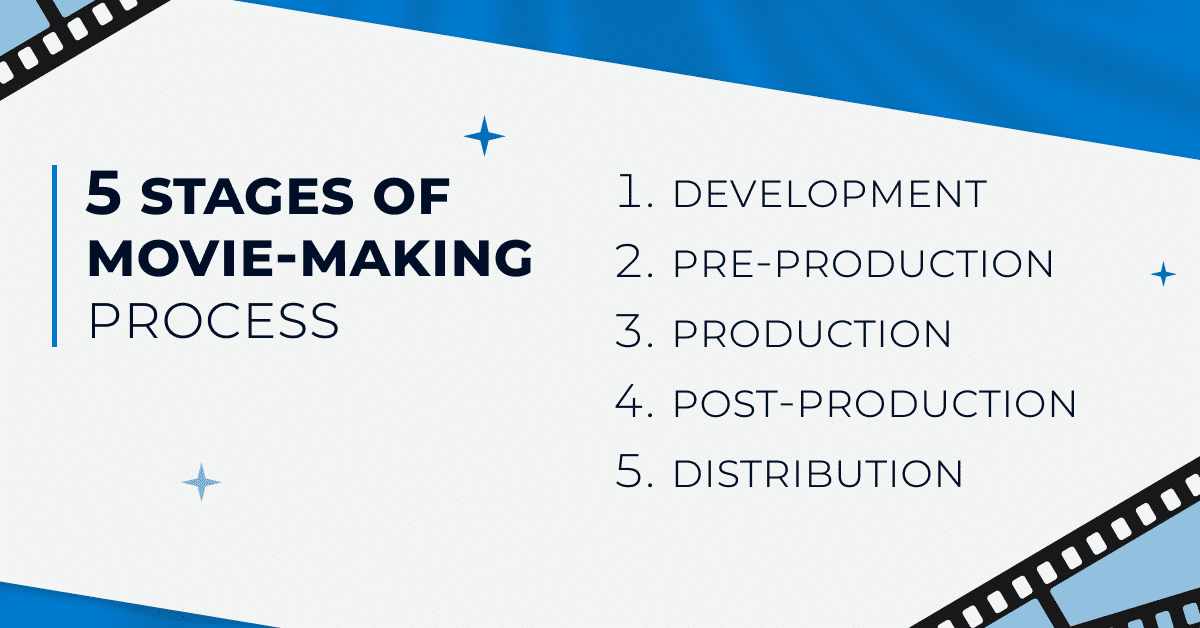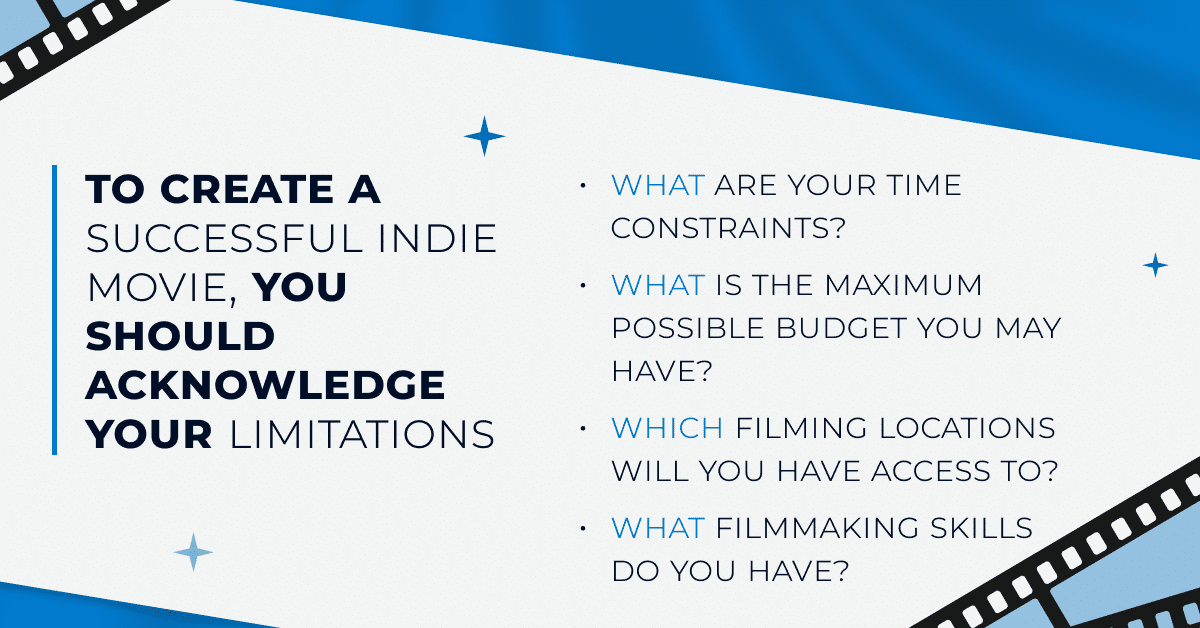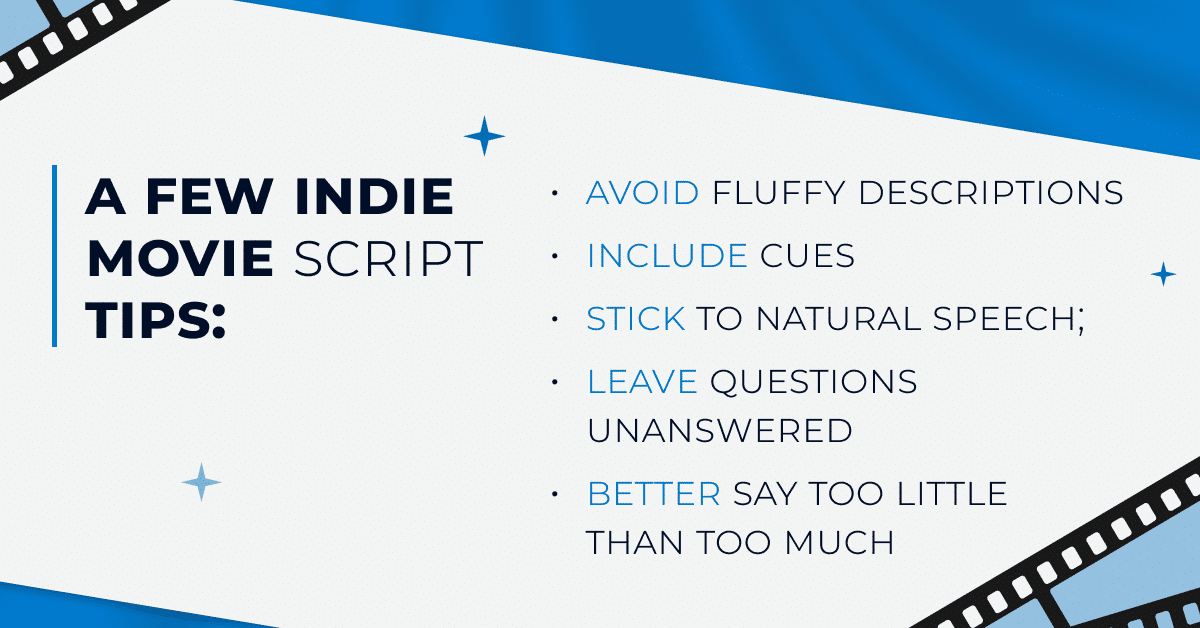How to make a low-budget indie film is a million-dollar question because shooting a movie is arguably the most complex form of artistic expression. Fortunately, you can break down the filming process into bite-sized pieces and slowly but surely bring your vision to the screen.
But first, you need an understanding of indie film creation, its caveats, and what it takes to make a low-budget film look good. This article will provide you with a guide on the indie filmmaking process to help you with the task.
What is a Low-Budget Indie Movie?
A low-budget indie movie is a movie produced by independent creators without the financial support of studios. Low-budget is roughly under $2.000.000, which is wild, but movie-making is expensive. On the flip side, there are no-budget and micro-budget indie movies that are created on a few sandwiches with tea or a couple of thousand dollars.
There are plenty of well-received indie movies that were created on a minimal budget. Such indie films are a prevalent phenomenon that becomes even more so with the advance of technology.
So, keep your spirits high.
In the indie film industry, the word independent means that NO studio or producer can dictate to you what you should and shouldn’t film. There are no focus group screenings to listen to, marketing research to follow, and trends you should include in your movie for mass appeal. You have complete creative control over making an indie movie, which is invigorating (and complete responsibility for keeping your team happy, safe, paid, and satiated).
The Five Stages of Indie Movie Production
Making an indie movie is a humongous piece of work.
And any humongous piece of work can be a paralyzingly-scary giant monster when you look at it from afar. But it becomes significantly easier to approach this monster when you break the work down into smaller parts. Then, it appears the monster was a bunch of small gremlins in a trenchcoat all along.


So, understanding the basic structure of filming an indie flick is important for planning and structuring your work (and dealing with the anxiety of facing the gremlins making a movie).
As follows, movie production has 5 stages:
1. Development stage
During the development stage of indie film production you develop the concept and idea of your film, figure out the scale of the project, write the draft of the script. You can also start figuring out the scale of the budget, contacting people who may help you in the production process, and gathering required information.
2. Pre-production stage
Pre-production is a meticulous planning stage of the indie movie production. During pre-production, you finish the script, find and book filming locations, develop a shooting schedule, plan your budget, gather equipment, hire crew and actors.
At the end of the pre-production phase, you should have everything you need to start and finish filming your low-budget indie film. Therefore, pre-production is arguably the most important stage of movie production as the quality of our planning will affect the quality of your execution and whether you’ve accounted for everything to ensure a smooth filming process.
3. Production stage
The production stage of indie filmmaking is when you start filming and directing your movie following the plan developed during the pre-production.
The production stage is also the part where you realize you’ve forgotten to account for something during the pre-production stage, so you should improvise on the spot and quickly find effective solutions.
In other words, the production stage is where your patience and stress-resilience of a true indie filmmaker get tested. But, hey, it’s not boring!
4. Post-production stage
The post-production stage — aka the editing stage — is when the computer screen and video editor become your or your film editor’s best friends. You pick the best shots, edit the movie, add sound effects and soundtrack as well as the final touches that make a polished final product.
5. Distribution stage
During the distribution stage, you promote and distribute your low-budget indie movie. It often means submitting to various festivals, contacting local cinemas that may be interested in lending their platform to aspiring local directors, and gathering your friends and family to show them the movie on a Friday night.


Keep in mind that this process is a more distilled, simpler version of the five stages of movie production. Low-budget indie films involve fewer people, less money, fewer stakeholders, and overall a lower scale of production capacities.
How to Make a Low-Budget Indie Film: Main Steps
Now, let’s answer the question, how do you make an indie film?
Development Stage
1. How do you start making an indie film?
First of all, creating a successful low-budget indie movie requires a certain mindset because you have limited resources and options.
So, to start making your indie movie, you should acknowledge your limitations first and plan your production around them.
[To create a successful indie movie, you should acknowledge your limitations first and plan your production around them]
So, before you start working on your low-budget indie film, determine
- What are your time constraints?
- What is the maximum possible budget you may have?
- Which filming locations will you have access to?
- What filmmaking skills do you have?


Use the insights to plan the movie that fits neatly within the borders of your possibilities.
Letting your limitations guide you may seem stifling to your creativity. On the contrary, though, limitations can be very conducive to inspiration. Without limitations, your mind starts wandering, jumping between thousands of different ideas or drowning in the stream of consciousness. With limitations, you obtain a clear-cut set of rules and can laser-focus on what you can do and not what you could do.
2. Develop a low-budget indie film idea
After you’ve acknowledged your limitations, you can start developing your low-budget indie movie idea. You may find yourself ignoring some of your previous film ideas in favor of simpler concepts, but it’s okay, in the future, you may have more opportunities. Save your dream films for later when you’re more experienced.
Usually, working around your limits in the indie world means focusing on a narrative-driven film with little to no action that takes place in a few locations. By the end of this stage, you should have an idea of who your characters are, where the film will take place, and what kind of story you want to tell.
Pre-Production Stage
3. Write a low-budget indie film script
At this point, you have an idea that will work for your limits and low budget. It’s time to give your idea a definite shape and write a script.
If you don’t have much experience writing scripts, you can take the script of the movie similar in scope and nature to yours and copy its structure. Don’t be afraid of being blamed for plagiarism — half the movies in Hollywood follow the same structure, and nobody cares. Copying structure is ok as long as you don’t copy dialogues and scenes.
A few low-budget indie film script tips:
- Avoid fluffy descriptions. Treat script as a guide for actors of what they should do and say on camera. Focus on key things and phrases, the minutiae can be directed during the shooting process.
- Include cues. [Reading intently] If you think, the phrase should be pronounced in a specific, non-intuitive way, specify how exactly.
- Stick to natural speech. Unless it’s dictated by the movie’s concept, it’s better to make your character sound as natural as possible.
- Leave questions unanswered. At the end of each act (except, maybe, the last one), your audience should crave answers to some questions. Will the character survive? What happens next? What present will the character get? Unanswered questions will keep your audience engaged.
- Remember, it’s often better to say too little than too much. Try to not over-explain things in dialogue.


It’d be great if you can show your script to a few people who can give constructive feedback. It’s difficult to judge the merits of your work, so it’ll be useful to hear from other people. But also, don’t let the possible negative feedback from other people discourage you from making the movie.
If writing a script is definitely not your forte, you can outsource it. Maybe some of your friends have the skills required to write a decent script. Or you can find a freelancer who can write it for the budget that suits your wallet.
Finally, you can dig around on indie filmmaking forums and find like-minded aspiring screenwriters who want to write a movie but haven’t had a chance yet. In this case, you can check out the following platforms for indie filmmakers:
- Indietalk — a forum for indie movie filmmakers and lovers
- NoFilmSchool Boards — the platform for indie creators
- ShootingPeople has “find work and community section — a network for filmmakers
- Cinematography.com — filmmaking forum
- r/filmmakers — subreddit for indie filmmakers
4. Budget your indie film
Claudie Pickering, the creator of the successful $5,000 comedy film Frisky suggests that you should spend most of your film budget on post-production, sound, and color to give your movie that polished look.
The majority of the work should be either done for free by you, your friends who share your passion and vision, or people who were promised the cut of the possible future profits.
Considering it, if you’re making an indie film for $10,000 or less you should expect to cover
- Salaries for actors and crew
- Equipment expenses
- Food (keep people well-fed and hydrated: they will be happier, and you will be calmer)
- Post-production expenses
To craft an indie film budget, you can follow these steps:
- Determine which parts of the filming process will cost you nothing. Is it editing, equipment, actors as all will be your friends?
- Determine which equipment you need and whether you can rent it, borrow it, or buy it.
- Make a day-by-day breakdown of your script, ie how many pages you’re planning to film per day. On average, you can expect to do 3-5 pages per day if all the scenes are in one location and nothing goes wrong (and on a set, something goes wrong like every other day). Don’t forget to leave more time for the most complex scenes — usually scenes with less talking and more action.
- Use the day-by-day breakdown to see how many days each actor will have and count their salaries. Usually, it’s a good practice to multiply the final sum by 2 to have a more accurate estimate and account for any delays.
- Do the same for any filming crew you will have on set.
- Determine the most expensive element of each day and plan around it. Is it too expensive? Cut corners then, rewrite the scene, choose something simpler, or find a person who can help you.
- Check whether you need to buy/rent or craft costumes or special items for each scene and determine how much it will cost you. Try to keep these expenses as low as possible. You want to spend your money on actors and production.
- Determine how much food and drinks you need for each day to keep all the crew well-satiated.
- Invest all the budget “leftovers” in post-production to make sure that the final cut is shiny.
Overall, try to keep your daily expenses below the daily allowance. You want to have extra cash for any inconceivable circumstances.
5. (Optional) Find sponsors for your low-budget indie film
You have your budget breakdown on hand, now you know how much money you need. If you don’t have that much money, you can
- Change something in the script or planned filming approach or cut losses by cutting corners
- Find sponsors
In the second case, you can
- Ask for money from relatives or friends who are willing to support your dreams without looking for a return on investments.
- Use crowdfunding platforms such as IndieGoGo, Kickstarter, Patreon,
- Try finding local NGOs, government initiatives, or philanthropies that support local artists.
Don’t think about taking credits or borrowing money from strangers. It’s not worth the risk. You can always shoot a decent no-budget indie movie with a smartphone and resourcefulness.
6. Get all the equipment you need to film an indie film
With budget, scouted locations, and plan at hand, you need equipment
- Low-budget indie film camera tips
Do you know that quite a few successful indie movies were filmed on a smartphone camera? The point is, you don’t need an expensive camera to shoot a fine movie.
Still, you can get some budget Canon or Panasonic for $400 – $600 or buy a used camera on eBay.
The trick to filming on a cheap camera is often shooting in monochrome. Yes, we know filming in black and white is kinda campy in the modern indie film scene. But who really cares what colors your movie has as long as it tells an enjoyable story?
It’s also ideal to have at least two cameras to film the same scene from different angles, which is super useful for editing.
- Low-budget indie film microphone tips
Do you know how bad-quality audio can transform even the clearest 4k video into a difficult-to-follow mess? And vice versa is true as well: good audio can make bad video tolerable and even enjoyable.
Here, this video proves a point.
The point is — if your camera lacks one, get a decent mic to record your actors.
- Low-budget indie film lighting tips
Professional lighting is expensive. Therefore, working with practical lights is a go-to approach for low-budget indie filmmakers.
Here are a few budget tips for good lighting:
- Shoot during the blue hour — a short time before the sunrise or after the sunset — for great night-time scenes;
- Shoot during the magic/golden hour — an hour before the sunset — for great daytime scenes;
- When filming in the daylight, position the actors with the sun behind them;
- If you’re planning to shoot with natural light, rehearse the scene beforehand to get the needed shots quickly;
- If you need a splash of light, a negative fill, or more light.use reflectors and flags — you can either DIY them or buy cheap options.
7. Scout locations for your low-budget indie film
It’s time to find filming locations. It’s better to focus on public spaces and ask around whether you can film for free in local entrepreneurs and public buildings. There’s also a third option, but we won’t suggest it.
We also suggest limiting the number of locations or picking those that are close together. Moving your crew from one place to another is expensive and time-consuming.
Go to locations, check how the lightning is there, and whether they have all you need for shooting a low-budget indie film.
Make 360-degree shots of locations on your camera. There are a few reasons it may help:
- The video will show you how the light works there;
- You’ll see where it’s better to position actors;
- You’ll see which time of the day works best for shooting there (you may want to visit a few times);
- if you lack shots for film runtime or some additional ambiance during editing, you can use filmed locations;
- You can also use the video with locations at home to better plan your future film shooting process.
You can even record the audio ambiance of locations for similar editing purposes.
8. Recruit low-budget indie film crew
You need people who will lend their skills to your low-budget indie film. The first line is asking around your friends and relatives.
The second place to look for a low-budget indie movie crew is craigslists and local online groups. Finally, if the budget allows it, you can try hiring professionals from local networks of filmmakers.
As for the payment, you can either pay with cash or offer a cut of future profits (or world fame and thousands of fans, of course).
9. Get clothing/create a wardrobe guide for your low-budget indie film
If your actors need some special clothing, you should prepare it. Check thrift shops and online shops to find cheap options.
If your low-budget indie movie doesn’t need any special costumes, you may want to create a wardrobe guide.
The guide should specify what clothes and styles actors should choose for each shooting day. With the guide, your actors will know how to dress to fit your movie’s atmosphere and suit each other, which is important for immersion.
Production Stage
10. Create indie film shot list and storyboards
A film shot list is a list of shots you need to take to create a movie. It can include description of shots, characters present, camera and lens used, camera angle and movement, shot type, location, and framing, and any additional notes you think are useful.
A shot list helps to streamline the shooting process, avoid confusion, and ensure that all shots are properly taken.
A storyboard is a visualization of the film sequence (think comic books). It consists of a series of drawings that show how the movie should look like.
Storyboards are completely optional in the case of low-budget indie films, but they can be useful in helping your crew understand your vision. So, if you have the time, reasons, and desire to draw, why not?
And remember, you don’t need to draw well to create effective storyboards.
Here’s a picture from a storyboard for the Knives Out by Rian Johnson and the respective film shot.


The storyboard serves its purpose.
11. Shoot and direct your low-budget indie film
The time has come to actually shoot the indie film. It was a long road up to this point, but you still have a lot of interesting work to do.
Your actors don’t have the same level of understanding your movie as you — the creator — do. Therefore, you need to direct them, help them feel each scene as you do, adjust their performance, and inspire them.
A few low-budget indie film directing tips:
- Don’t be hard on your actors;
- Help them develop their characters before filming;
- Share your vision in detail bud don’t overload them with irrelevant information;
- Describe to them how the character ought to feel in the key scenes;
- Be open to improvisations and changes to your vision — a film is a communal effort;
- Praise their great performances.
An actor without a good director results in a confused, unconvincing character.
Post-Production Stage
12. Edit your low-budget indie movie
Edit, edit, edit. We don’t have much to add here besides
- Ensure proper color grading on all shots;
- Ensure proper audio levels so all dialogue is equally audible and loud effects don’t threaten to blow up viewer’s ears;
- Use the best shots available and don’t forget about adding some meat to your movie with some shots of the environment that create atmosphere.
13. Market your low-budget indie movie
At this point, you should have some indie movie posters, trailers, and other key art to help you with promoting your low-budget indie film.






Besides that, indie movie prompton is an art and a craft that takes a lot of passion and dedication as well. Here’s an article on the platforms you can use to promote your indie movie.
Top 14 Effective Platforms for Low-Budget Indie Movie Marketing
The marketing stage will persist throughout the distribution stage.
Distribution Stage
14. Distribute your low-budget indie movie
As we’ve already mentioned, the distribution of your indie film comes down to submitting it to festivals, looking for local cinemas that can show it, and seeking opportunities online on indie-focused streaming platforms.
You can read more about short indie film distribution platforms in our article.
Short indie film distribution platforms
And… Cut!
Well, that’s it!
Congratulations as at this point you should have a low-budget indie movie on your hands. You must be eager to hear how people react to it or extremely anxious to show it to the audience. In any case, you should be proud of yourself as putting a movie together even with prior experience is an impressive feat. We hope you know better how to make a low-budget indie film and your future movie finds its audience, brings you joy, and motivation to create more.








